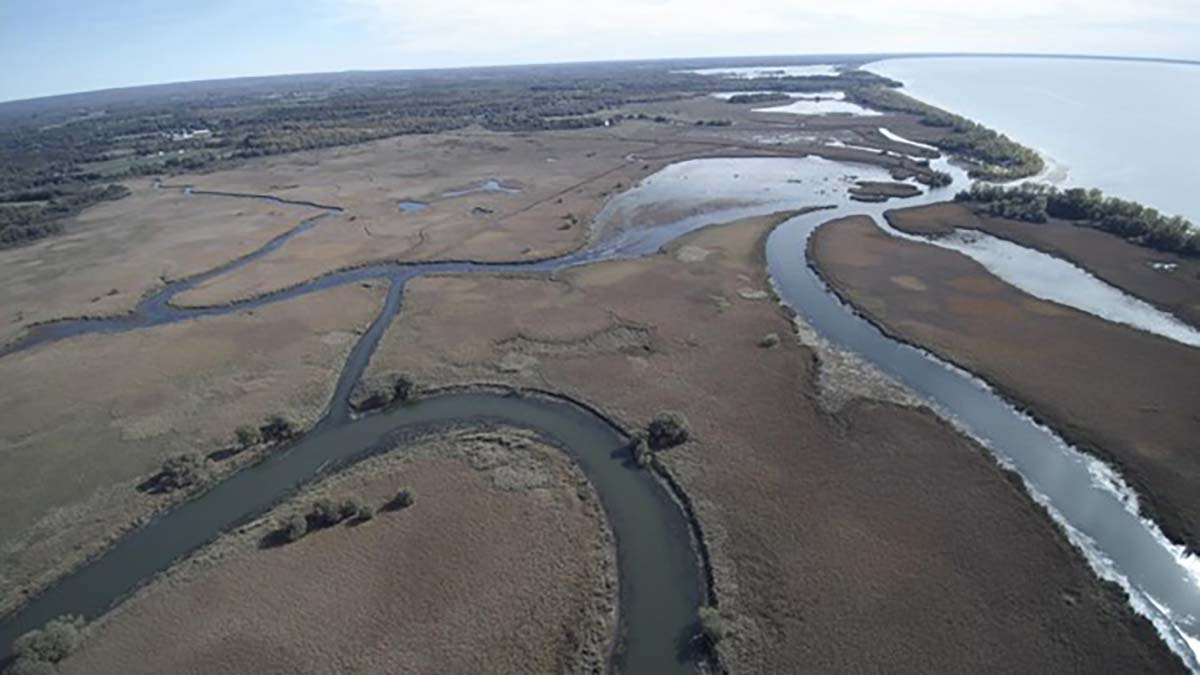Lakeview WMA Project has Multi-Species Impact
Northern pike, black terns, black ducks and other wildlife will benefit from this public-land conservation work
Northern pike, black terns, black ducks and other wildlife will benefit from this public-land conservation work

An aerial view of the completed work at Lakeview WMA.
Ducks Unlimited and the New York State Department of Environmental Conservation (NYSDEC) completed a wetland enhancement project at Lakeview Wildlife Management Area (WMA), improving spawning and nursery habitat for fish, as well as breeding areas for waterfowl and declining bird species, like the state-endangered black tern.
The work, funded by the Great Lakes Restoration Initiative (GLRI) and U.S. Environmental Protection Agency, impacted 150 acres, creating more recreational opportunities at the WMA, including waterfowl hunting, bird watching, fishing and kayaking.
“Wetlands perform crucial functions for the environment, fish and wildlife, and the public by protecting water quality, increasing resilience, and providing recreational opportunities like fishing, hunting, and wildlife observation,” NYSDEC Commissioner Basil Seggos said. “NYSDEC is thankful for the dedication of our partners at the National Oceanic and Atmospheric Administration, Great Lakes Commission, Audubon New York, Audubon Great Lakes, and Ducks Unlimited, as the joint efforts at Lakeview WMA will enhance wildlife habitat and increase opportunities for visitors to enjoy the outdoors.”
Located along the eastern shoreline of Lake Ontario, the 3,461-acre WMA is part of the largest natural freshwater barrier beach system in New York. The area's diverse habitat includes open fields, shrublands, woodlands, wetlands and a natural barrier beach. Lakeview is open to the public year-round, though public use restrictions apply to the sensitive barrier beach system.
Due in part to a lack of fluctuating water levels, the habitat at Lakeview became less diverse, with increasing stands and mats of dense cattails and encroachment of other invasive plant species.
“The Great Lakes Commission (GLC) is proud to have been part of the collaborative effort that implemented the marsh restoration project at Lakeview WMA,” said Erika Jensen, executive director of the GLC. “Nearly $700,000 of GRLI funds were directed to this project through our partnership with the National Oceanic and Atmospheric Administration, which supports the restoration of vital Great Lakes coastal habitat.
“This work resulted in the restoration of fish and wildlife habitat along Lake Ontario, providing both ecological and economic benefits such as improved wildlife viewing and fishing opportunities. Projects like this demonstrate the strong return on investment of restoring and protecting the Great Lakes.”
A conservation tactic known as channeling and potholing was used to help restore wetlands. An excavator digs out the floating cattail mats to create open water habitat and inhibit cattail regrowth. DU also constructed 15 acres of potholes. This technique improves the natural flow of water, interspersion of open water, and habitat connectivity to benefit spawning northern pike and other fish. Breeding habitat for nesting black terns and migratory birds will also be reestablished.
“The work Ducks Unlimited and our partners have completed at Lakeview WMA, will enhance nesting, breeding, and foraging areas for waterfowl and water-dependent species for years to come,” said DU Regional Biologist Mathew Wagner. “It’s exciting to see this project completed and we look forward to continued relationships with conservation partners to address quality habitat in these critical migration areas. We've created more opportunities for wildlife to flourish and hope to continue this momentum with similar enhancement approaches.”
Media Contact:
Joe Genzel
(309) 453-0979
jgenzel@ducks.org
Ducks Unlimited uses cookies to enhance your browsing experience, optimize site functionality, analyze traffic, and deliver personalized advertising through third parties. By continuing to use this site, you agree to our use of cookies. View Privacy Policy